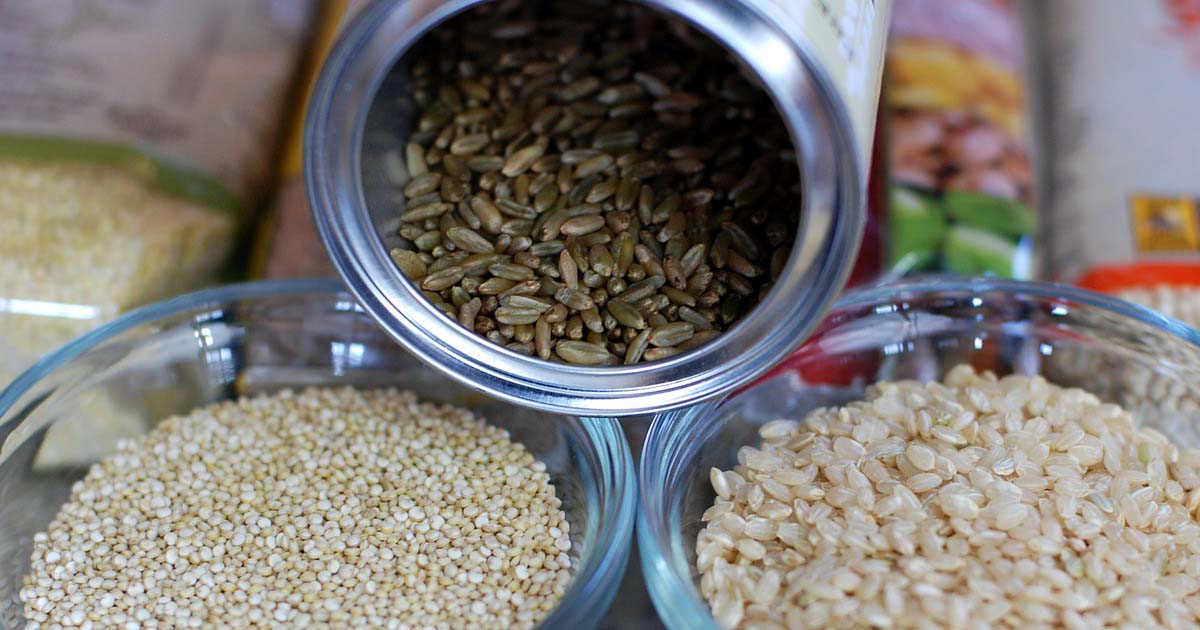100 Non-Perishable Foods For Your Supply


[ad_1]
There are tons of non-perishable foods which don’t require refrigeration – many of which also require no cooking and can last for years or even decades.
These foods are great for making an emergency stockpile. They are also great for van life and camping.
Instead of listing each individual food, I’ve narrowed it down by category. Then I’ve listed non-perishable foods which fall into the category.
Tip: When building up a stockpile of non-perishable foods, balance carbs, proteins, fruits/veggies, and healthy fats. You don’t want to end up just eating dry pasta or peas from the can! Variety means you’ll have more nutritious and appetizing meals.
See our long-term food storage list.
Dry Foods
This is what usually comes to mind when thinking of shelf-stable foods. These dry foods can last for years without refrigeration or special storage methods. However, they can succumb to mold growth, pest infestation, and oxidation.
If you want dry foods to last for a long time out of the fridge, you’ll need to repackage them in Mylar bags with oxygen absorbers.
- Grains: Such as instant rice, quinoa, couscous, barley…
- Flours: Whole grains last longer than flour. You can still stockpile flour, though. Keep them in a cool, dry place, or repackage them in Mylar bags with oxygen absorbers. See how to store flour for the long term.
- Beans and lentils: Note that these take a very long time to cook. See how to store beans for the long term.
- Dried bean powders: Includes instant refried beans, hummus mix, and falafel mix. The brand Fantastic also makes a black bean mix and vegetarian chili mix.
- Cereals: When unopened, most boxed cereal will last around 1 year past the expiration date.
- Pasta: The expiration date of pasta is usually 1-2 years, but it is generally still safe to eat past the expiration date. Discard if there are signs of mold or if it becomes slimy when cooked. See how to store dry pasta.
- Tortillas: The expiration date on these varies, so check before you stockpile them.
- Instant mashed potatoes
- Dehydrated fruits and veggies: Note that home-dehydrated foods don’t last as long as store-bought ones. Read how to dehydrate food and how long does dehydrated food last.
- TVP: This stands for textured vegetable protein. There’s also textured soy protein (TSP) cook in water, and you’ve got a healthy vegetarian protein. Get it on Amazon.
- Jerky – How to store beef jerky
- Powdered eggs
- Oatmeal
- Pancake mix – Store pancake mix long term
- Baking mixes
- Cacao
- Nuts
- Seeds
- Breadcrumbs and croutons
Canned, Jarred, and Pouch Goods
In addition to not requiring refrigeration, these foods can (in theory) last forever and are good to eat long past their expiration dates. I prefer canned foods over jars because glass can break easily.
If you do want to stockpile jarred food for disaster preparedness, be sure you use earthquake-proof shelving.
While easy to stockpile, canned/jarred foods aren’t always the healthiest option. Savory foods are loaded with sodium, and fruits are often loaded with sugars.
I’ve divided the list of canned and jarred foods into categories by type. Remember to get a variety of every kind of food.
Fruits and Vegetables
- Pickles: Think beyond pickled cucumbers. Pickled peppers, carrots, and asparagus are some yummy options. Read more about home pickling.
- Vegetables: Firmer veggies like peas and beets don’t get as mushy when canned and are thus better choices.
- Fruits and fruit sauces: Whole fruits, jam, applesauce, cranberry sauce
- Mushroom gravy
- Tomatoes
- Olives
Proteins
- Peanut and other nut butters: Note that some nut butters (like pistachio) go rancid quickly.
- Beans and lentils
- Meat: In addition to Spam, there are now endless options for canned beef, chicken, turkey, sausages, bacon, and more. You can also find some meats in pouches.
- Tuna and other fish: Look for pouches in addition to cans.
- Hummus: This is great for spreading on crackers for an easy lunch. You can also buy dry hummus and falafel mixes.
- Gluten: Also known as seitan, it’s often found in Asian stores. It’s pure protein and definitely not gluten-free! Get it on Amazon.
Meals
- Pasta meals: Spaghetti-Os, ravioli, spaghetti and meatballs, Beefaroni
- Soups and stews
- Chili
- Dolmas: These are grape leaves stuffed with rice and are a personal favorite of mine; they can be found in Greek specialty stores or on Amazon
- Eggplant stuffed with rice: Another favorite of mine; found in Middle Eastern stores or on Amazon.
- Peppers stuffed with cheese or rice: These are gourmet as hell and delicious!
Other Canned Goods:
- Canned cheese: Including nacho cheese spreads, spray cheese in a can, and other processed cheeses.
- Bread: Yes, this is a thing! The brand B&M makes canned brown bread.
- Canned Butter: It tends to be very expensive but is a good treat if you don’t have refrigeration for real butter.
- Desserts: Like canned cake and pudding. It’s easier than making them from scratch, especially if you are without power.
- Milk: Besides regular milk, you’ve got options like condensed milk and coconut milk.
Instant Meals
Instant meals are the easiest foods that don’t require refrigeration. You usually dump the entire contents into boiling water and cook for a few minutes.
Many instant meals don’t even require cooking: they can be made by soaking in water for about 15 minutes (more on that later).
- Boxes meals: Think Hamburger Helper, Mac and Cheese, Stove Top Stuffing, Near East meals, and Rice Sides. Remove them from the box for the best shelf life and repackage them in Mylar bags.
- Self-heating meals: These have packaging which has a heating element in it. One popular brand is Chef 5 Minute Meals.
- Backpacking and emergency freeze dried meals: There are tons of these. Check out our top picks here.
- Freeze dried bulk foods: You can also build meals out of freeze dried staples, like freeze dried veggies mixed with freeze-dried meat and cheese powder.
- MREs: This stands for Meals Ready to Eat and usually refers to military-style emergency food rations.
- Ramen: This is probably the cheapest shelf-stable food you can get. Make it more nutritious by adding canned veggies and proteins to it.
Sweeteners
Most sweeteners will last forever without any special packaging. Keep them where insects (especially ants) can’t get to them. Even if they get infested, most insects are edible and nutritious!
- Sugar – See how to store sugar for the long term
- Honey – See how to keep honey
- Maple Syrup
- Molasses
- Corn syrup
Flavorings and Condiments
Don’t forget to stock up on shelf-stable flavorings and condiments, or your meals will end up bland. Almost all of these can last for years unopened. Once opened, most condiments will keep for 1 month (or even 1 year!) without refrigeration.
- Vanilla extract and other extracts
- Herbs and spices
- Seasoning Mixes
- Bouillon cubes and broth
- Soy sauce
- Ketchup
- Mustard
- Mayonnaise
- Salad dressings
- Vinegar
- Salt
- Sauces and Spreads: BBQ, horseradish, salsa, pesto, cheese, cheese sauce mixes…
- Nutella chocolate/nut spread
Staples and Baking
It’s pointless to stockpile dry flour if you aren’t also going to stockpile these staples, many of which are required for baking. I’ve also found that olive oil makes bland grains taste much better.
- Cornstarch –Uses: cosmetics, removes stains, loosens knots. See, Does cornstarch go bad?
- Baking soda -zillion uses
- Baking powder – see how to store baking powder
- Dry yeast
- Cooking oil and shortening – see how to store cooking oil
Beverages
- Instant coffee
- Vitamin drink packets
- Tea
- Creamer
- Powdered milk – See how to store dried milk for the long term and how to make dried milk
- Canned milk
- Juice boxes
- Alcohol
- Coconut milk
- Powdered yogurt
- Meal shakes
Snacks
Most snack foods are so full of chemical additives that they can last for years without refrigeration or special storage. The main issue is that their packaging is very bulky, so they take up a lot of space. Because of space issues, I wouldn’t recommend stockpiling items like chips or popcorn.
- Crackers
- Gelatin/Jell-O
- Pudding mix
- Chips
- Protein bars
- Granola bars
- Pop tarts
- Rice cakes
- Trail mix
- Cookies
- Popcorn – read, do popcorn kernels go bad?
- Pretzels
- Chocolate
- Candy
- Gum
Supplements
- Multi-vitamins
- Protein powder
- Greens powder
Bonus List: Foods That Don’t Require Refrigeration or Cooking
When the power is down, your refrigerator and the electric stove won’t work. If you are prepping for power outages or another disaster, I recommend getting a small stove. I like propane backpacking stoves best, but there are plenty of other options.
What if it isn’t safe to cook, such as during gas leaks? Or what if you run out of fuel? Then you can use the cold soak method.
The cold soak method involves soaking food in cold water until it softens. A lot of foods can surprisingly be made this way. Many taste better when heated, but it’s a good method to know in a pinch.
Here’s a list of foods that can be made with the cold soak method.
- Oatmeal with freeze-dried fruits: Soak for 5-10 minutes or until desired softness. Dehydrated fruits take much longer to soften.
- Instant mashed potatoes: Soak for 1 minute.
- Ramen: Soak for 15-30 minutes or until it is completely soft. *Pastas, unfortunately, need to be cooked to break down the proteins.
- Couscous: Soak 20-30 minute.s
- Instant rice: Soak for about 2 hours.
- Hummus mix: Soak for 10 minutes.
- Cream soups (no noodles or pieces of vegetables): Soak for 10-30 minutes.
- Rice noodles: Soak for 1 hour.
- Freeze dried backpacking meals (no noodles or pasta): Most backpacking meals are designed to be cooked, so they can’t be made this way. However, the ones without any pasta in them can usually be cold-soaked.
Adding things like canned veggies, meat from cans or pouches, olive oil, and seasonings can make these foods more interesting. Instant hummus can be spread on crackers or tortillas. You can make dozens of great no-cook, no-refrigeration meals once you start experimenting.
What are your favorite meals which don’t need refrigeration or cooking? Let us know in the comments section below!
[ad_2]
Source link
Recent Posts
Dear Diary, It’s Me, Jessica: Part 16
[ad_1] If you're new here, you may want to subscribe to my RSS feed. Thanks…
Google Faces Lawsuit After $5M in Crypto Stolen via Play Store App
[ad_1] A Florida woman, Maria Vaca, has sued Google in a California state court, alleging…
All About Water Purification: A Complete Tutorial
[ad_1] You may need to purify water to make it safe to drink. The process…
Protocol Village: Quai Releases Mainnet-Compatible Devnet, Crunch Lab Raises $3.5M
[ad_1] The latest in blockchain tech upgrades, funding announcements and deals. For the period of…
The Grim New Daily Life in Venezuela
[ad_1] If you're new here, you may want to subscribe to my RSS feed. Thanks…
World’s 3rd largest public pension fund buys $34M MicroStrategy shares
[ad_1] The third-largest public pension fund in the world has just bought nearly $34 million…
